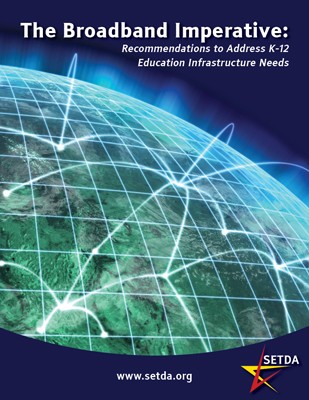SETDA on E-Rate Modernization
It is a simple fact that in 2014 access to high-speed broadband is now as vital a component of K-12 school infrastructure as electricity, plumbing, air conditioning and heating. The same tools that have transformed and enriched our personal, civic and professional lives are dramatically improving learning experiences intended to prepare today’s students for college and 21st century careers. Given that bandwidth capacity determines which online content, educational applications, and digital learning services students and educators can use effectively in the classroom, it is in the national interest to ensure a baseline broadband capacity in and throughout all schools and to incent continued digital learning innovation.
Recognizing the complex and inter-related nature of the issues under consideration, SETDA has further developed the ideas in our landmark 2012 report, The Broadband Imperative: Recommendations to Address K-12 Education Infrastructure Needs, and advanced seven guiding principles for E-rate modernization in our public comments to the FCC (on September 16, 2013 and April 7, 2014):
- Principle #1: A modernized E-rate should be guided by a few, clear performance goals and metrics, which should include the broadband capacity targets advanced by SETDA (100 Mbps per 1,000 students and teachers today, rising to 1 Gbps per 1,000 students and teachers in the near future), as well as targets related to: recurring costs incurred by participants for broadband service, the administrative burden of program participation, and program participation rates.
- Principle #2: A modernized E-rate must better align to education needs and governance responsibilities, including by better aligning program operations to existing state and local education authority governance and accountability structures and by building the capacity of the existing education governance system to meet its broadband needs over time.
- Principle #3: A modernized E-rate must prioritize equity of access to robust broadband by 100% of schools, ensuring that a baseline broadband capacity is available to and throughout all schools in the nation, including rural schools.
- Principle #4: A modernized E-rate must be fiscally responsible and focused on driving down the average recurring total monthly cost per MB of school internet connection capacity over time.
- Principle #5: A modernized E-rate should incent participant innovation, by increasing freedom for participants to develop and deploy the most cost-effective approaches and technologies in line with program goals and adopted state and local plans and priorities. Moreover, special studies and pilots should be supported to the degree they accelerate achievement of program goals for all schools and lead to continuous improvement of the program over time.
- Principle #6: A modernized E-rate should reduce participant burden. Program complexity drives up costs, decreases participation, and reduces innovation.
- Principle #7: A modernized E-rate must provide specific, predictable and sufficient funding to address K-12 broadband infrastructure needs. Data on school broadband needs point to the fact that a modernized E-rate will need increased funding, including for capital investment necessary to ensure an abundant, affordable supply of broadband to the nation’s schools over time.
Since its formal launch in 1998, the E-rate program has been an astounding public policy success in helping public and private schools and libraries get connected to the internet. Fifteen years later, the E-rate finds itself on the verge of an inflection point that could herald dramatically improved student success in local communities from coast to coast.
By offering a forward-thinking set of principles, SETDA proposes an approach to modernizing E-rate that would better meet the evolving needs of all schools and students in a digital age. At the same time, we believe our approach preserves the unique and important roles of federal, state and local governments and the private sector.
Broadband is the enabling technology of modern learning environments, and broadband concerns should never be a factor when teachers or students are planning for educational activities. Unless we swiftly and systematically move to address the dearth of bandwidth capacity in schools nationwide, we will find it to be the limiting factor in school reform and improvement.

